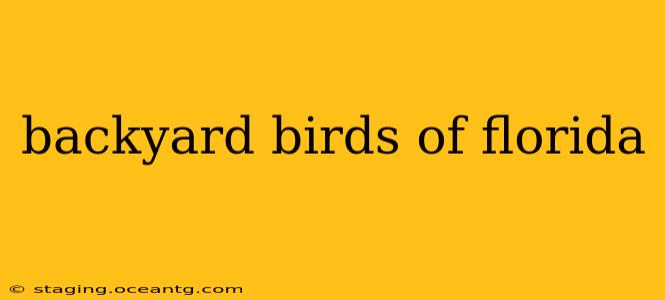Florida's diverse ecosystems provide a haven for a vibrant array of bird species, many of which grace backyards across the state. From the brightly colored cardinals to the sleek herons, observing these feathered friends can be a rewarding and enriching experience. This comprehensive guide explores the common backyard birds of Florida, offering insights into their identification, behaviors, and how to attract them to your own outdoor space.
What are some common birds found in Florida backyards?
Florida's backyard birdlife varies depending on location and habitat, but several species are consistently seen across the state. Northern Cardinals, with their vibrant red plumage (males) and brown (females), are a ubiquitous sight. Mourning Doves, known for their gentle cooing, are equally common. Other frequent visitors include Blue Jays, with their striking blue and white markings, and Carolina Chickadees, tiny but energetic birds with black caps and white cheeks. Depending on proximity to water, you might also spot Great Blue Herons, or even smaller species like the Green Heron, stalking prey in your garden. Smaller birds like various species of warblers, wrens, and finches also frequent Florida backyards, adding to the biodiversity.
What birds live in Florida year-round?
Many bird species are year-round residents of Florida, making them a constant source of delight for backyard birdwatchers. Northern Cardinals, as mentioned, are permanent residents. Similarly, Mourning Doves, Blue Jays, and Carolina Chickadees are all non-migratory birds that call Florida home year-round. Various species of woodpeckers, like the Pileated Woodpecker and the Downy Woodpecker, are also year-round residents, adding to the visual interest of the backyard. Remember that the specific species present will also depend on the type of habitat available – a backyard with tall trees will attract different birds than one with primarily shrubs.
How can I attract birds to my Florida backyard?
Creating a bird-friendly backyard involves providing the essential elements that birds need for survival: food, water, and shelter. Offering a variety of bird feeders stocked with sunflower seeds, nyjer seeds, and suet will attract a wide range of species. Fresh water sources, such as a birdbath, are crucial, especially during hot and dry periods. Maintaining a variety of native plants and shrubs will provide natural cover and nesting sites, making your backyard a more attractive and secure habitat for birds. Avoid using pesticides and herbicides, as these can harm birds directly or indirectly by reducing their food sources.
What kind of food do Florida backyard birds eat?
The diet of Florida backyard birds is diverse, reflecting the abundance of available food sources. Many species, like cardinals and blue jays, are omnivorous, feeding on seeds, berries, insects, and nuts. Smaller birds like warblers and chickadees primarily consume insects, while others, such as doves, rely heavily on seeds. Providing a diverse range of food sources in your feeders will attract a wider variety of birds. You can also supplement feeders with natural food sources by planting berry-producing shrubs and trees.
What are some good plants to attract birds to my Florida backyard?
Native plants are key to creating a thriving bird habitat. Consider planting native shrubs like beautyberry, which produces vibrant purple berries that are a favorite among many bird species. Various native trees, like oak trees and hollies, also provide food and shelter. Flowers such as sunflowers and coneflowers attract nectar-feeding birds and insects, which in turn attract insectivorous birds. Researching plants native to your specific region of Florida will ensure that you're attracting species that thrive in your area and contribute to the local ecosystem.
What are some tips for identifying Florida backyard birds?
Accurate identification often relies on a combination of factors. Start by observing the bird's size and shape. Note the color and pattern of its plumage, paying attention to details like wing bars, breast markings, and head patterns. A good field guide, binoculars, and a bird identification app can be invaluable tools. Learning the bird's calls and songs can also aid in identification. Consider the habitat where you observed the bird – this can narrow down the possibilities. Websites and online resources provide additional pictures and sounds to help with identification. Join local birding groups or attend guided bird walks to learn from experienced birders.
By implementing these strategies and taking the time to observe your feathered visitors, you can transform your Florida backyard into a vibrant and thriving bird sanctuary. Enjoy the beauty and wonder of these remarkable creatures!
